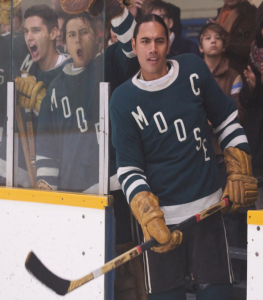By Ashley Bowden
Arts & Entertainment Editor
The powerful history of Native Americans that has often been overlooked in studies of America’s past comes to light in the film “IndianHorse.” The movie is an adaptation of a novel by Richard Wagamese of the same name. It depictsthe struggles of the country’s indigenous peoplein the 60s and 70s as they were forced to conform to a culture not their own. In partnership with the CANA Foundation, a global rewilding organization, the LIU Global Institute will present an exclusive screening of the film on April 16 at 6 p.m.in the Gold Coast Cinema. Thanks to Steve Israel, chairman of the Global Institute, the student bodywill have the opportunity to view the film.

Saul Indian Horse in Catholic school
Will Strongheart, who plays Virgil Kelly, hockey team captain, in the film, will be present at the screening, along with producer Paula Devonshire, for a Q&A session with the audience. “We want to engage [in] some dialogue so we can talk about reconciliation,” Strongheart said.“ A lot of people are unaware that the status of our native people has a lot to do with the traumatic stresses that were suffered through [residential] schools.”
The story follows a young Native American boy named Saul Indian Horse as he is confronted with racism when forcibly enrolled in a residential school in Canada. Residential schools were common in both Canada and the U.S. in the late 19th and mid 20th centuries. “For indigenous children, it was mandatory that they were subject to this school and basically stripped of their culture to blend in to the new Western culture,” Strongheart said. One scene in the film depicts young Indian Horse (Sladen Peltier) having his long hair cut
by Catholic nuns, signifying a great loss of part of himself.
As a child, Indian Horse is robbed of his culture, family and language and finds sanctuaryin playing on an all-Native American hockey team. “He’s isolated from everything that he is, so he uses that as an opportunity to heal and cope with what’s going on,” Strongheart said. Indian Horse gradually improved and rose in the ranks of the hockey team, the Moose. “All along, he’s battling the demons that he’s inherited through the traumatic stress that he’s suffered through the school,” Strongheart said.
Strongheart’s character, Virgil Kelly, becomes an adoptive older brother to Indian Horse after Kelly’s father removes him from the residential school. They work to hone the younger boy’s hockey skills so that he can eventually advance to play hockey in a league beyond the school.

Virgil Kelly, captain of the Moose Hockey team
The film sheds light on truths that would otherwise go unrevealed, according to Strongheart. “We’re hoping to build the bridge between truth and reconciliation,”he said. Strongheart hopes the film will mend relationships between indigenous people and the Canadian government that implemented residential schools.
The Truth and Reconciliation Commision of Canada, founded in 2008, seeks to educate the Canadian population about what happened to indigenous people within residential schools. “The ball is moving forward; globally, people are accepting of [our history],” Strongheart said.
Strongheart is glad to be screening the film at Post because of the diversity of the student body. The film’s popularity in Canada stems from the country’s abundance of native inhabitants. “Where we live, the narrative of native people isn’t as high, so you get a multitude of students there with openness and willingness to listen to these stories,” Strongheart said, “The hope is to spread the message, and I know that LIU Post is a great platform to do that.”
Since his parents attended a residential school (the last one closed in 1996), Strongheart has a strong personal connection to the film. “It’s been around all my life; I’ve seen the results,” he said. Strongheart grew up in Kansas but spent a majority of his life in Canada. 
Alcoholism and other problems permeate the Native American community, according to Strongheart, caused by the depression the population faced in previous decades. “That trauma was passed down like a torch, and I inherited that from my own parents,” he said,“I heard the stories first hand from their mouths and it was very, very dark.”
The other actors have a similar connection to the story, according to Strongheart. “We’ve all lived it, it isn’t just a role; we’ve all come from the ashes of those schools,” he said. The process was deeper than what the audiences see on screen. Over the nine-month long filming of the project, the creative team was respectful of the cast and their rituals, including smudging, a method of purification using the smoke of sage. Filming scenes with racial tension were especially heavy for the actors. “Those are real tears,” Strongheart said about the emotion portrayed in the film. “Whether we were being spit on or being made fun of because we were Native, we had to walk off set and smudge off that negativity,” he said. He compared the process of revisiting painful memories to opening up an old wound, but overall it was healing because of the supportive family environment they worked within.
“This isn’t fiction; you’re getting into the heart and soul of people and what was taken from us,” he said. Much of the cast is first-time actors.
“Indian Horse” was shown worldwide at film festivals across Canada, the U.S, and France. The movie has won awards including audience choice for best picture at the 2017 Vancouver International Film Festival. Sladen Peltier received the award for best supporting actor at the 6th Canadian Screen Awards for his portrayal of young Saul Indian Horse.
“These are stories you don’t see in your history books, but they are part of this history,” Strongheart said.







Be First to Comment